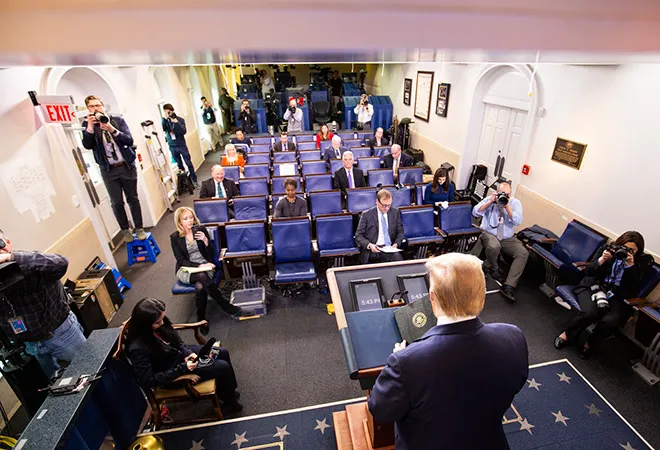
The WHO Director-General recently deemed the novel coronavirus to be an “enemy against humanity”, as the number of infected crossed 470,000 globally. Since being confirmed as a pandemic earlier this month, little breakthrough on a prospective vaccine has rendered social containment strategies to be key for stalling the spread of the COVID-19.
But as the pandemic concurrently also feeds an “infodemic” — an “overabundance” of information that makes it “difficult for people to identify truthful and trustworthy sources from false or misleading ones,” calls for preventive actions like “social distancing” have failed to accrue compliance in many places around the world. Amidst the resultant cacophony of unbridled fake news and hysteria-inducing home remedies, crisis communication stands further impeded by the politicisation of such global health emergencies.
Case in point: US President Donald Trump, who is up for reelection later this year, has impeded prospects of any multilateral cooperation by exploiting the pandemic as an opportunity to actualise the ‘America First’ agenda vis-à-vis China, Mexico and Iran.
COVID-19 and the China factor in 2020 US presidential elections
In the past few days, Trump has come under fire due to his description of the coronavirus — which is considered to have originated in a food market in Wuhan, as the “Chinese virus”. His Secretary of State Mike Pompeo invited criticism for referring to it as “Wuhan virus”. Republican Sen. Tom Cotton (R-AR) has often used that term on the floor of the US Senate. The top Republican leader in the House of Representatives Rep. Kevin McCarthy (R-CA-23) also referred to the disease as “the Chinese coronavirus” in a tweet. Lastly, CBS White House reporter Weijia Jiang revealed that White House aides are referring to the virus as “Kung-Flu” in interactions with journalists.
Certainly, China bears responsibility for the "lack of transparency" over its initial response — which probably contributed to the exacerbation of a local virus into a global pandemic. However, use of the aforementioned terms contribute to stigmatisation of the Chinese — which is also feeding assaults on Asian Americans, and hold relevance to Trump’s 2020 reelection bid.
In 2016, Donald Trump’s populist takeover of the Republican Party occurred largely due to his capitalisation on Americans’ anxieties with the US’ traditional commitment to globalisation. Trump’s strategy encompassed rallying against the Washington establishment’s long-standing advocacy of free trade — chiefly with China, yielding “unacceptable outcomes” for blue-collar workers in America’s industrial mid-west.
After engaging in a trade war of tariffs and retaliatory tariffs with China for 18 months, the Trump administration recently only exacted a limited Phase One trade deal. Catering only to the latter half of Trump’s banner call for “fair and reciprocal” trade, the deal merely includes commitments from Beijing to increase imports from Washington by at least USD 200 billion over two years. With little progress on seeking Chinese structural reform on intellectual property theft and forced transfer of technology, Trump’s domestic political agenda on China remains unfulfilled.
Ahead of the 2020 elections, the “Chinese virus” presents Trump with an opportunity to once again make China a centrepiece in his run for president.
Already, the US president has begun to shift blame on China as the Dow Jones Industrial Average plunged 9,000 points in the last month — i.e. “below its closing level from President Trump's inauguration day, effectively wiping out all gains made during his presidency”. In announcing his support for industry bailout packages, Trump recently posted a tweet suggesting China was “responsible for the global economic damage”.
Thus, the interlinking of the already slowing American economy to the “Chinese virus” spooking markets can be expected to figure prominently in Trump’s courtship of Rust Belt states. In 2016, those states — Wisconsin, Michigan and Pennsylvania, were instrumental in catapulting Trump to the White House. In 2020, the fight for those states will be tougher on account of Democratic front-runner and former Vice President Joe Biden having the advantage of being the “native son” of Pennsylvania — which Trump picked up in 2016 by less than 45,000 votes.
In addition to seeking the extension of his mandate on China — and by that extension also his stay at 1600 Pennsylvania Avenue NW, Trump is exploiting COVID-19 to also further his policy on the US border with Mexico.
COVID-19 and immigration flow on the US border with Mexico
Another facet of Trump’s 2016 run was his capitalisation on Americans’ socio-cultural anxieties. He offered a reductionist solution to stalled immigration reform — i.e. to build a wall on the US-Mexico border to curtail illegal immigration.
Over the course of Trump’s term, however, he has gone toe-to-toe with the US Congress — which is constitutionally mandated to exercise power over the purse, to secure funding for the border wall. But Congressional Democrats, and some Republicans like Will Hurd (R-TX-23) as well, have argued against funding “a 4th Century solution to a 21st Century problem”. Although Trump has secured piecemeal funding on a couple of occasions, his political opponents on the Hill stress on the adoption of technology — and not a concrete structure that stretches from “sea to shining sea”, like advanced sensors and surveillance platforms to track incursions.
The Trump administration’s attempts to circumvent the stalemate have also been challenged in American courts. For instance, the White House’s 2018 declaration of refusing asylum applications of those who have crossed the border illegally from Mexico, has been blocked. Just last month, the 9th US Circuit Court of Appeals in San Francisco also issued an injunction on that policy, in addition to another Trump policy on requiring immigrants who apply for asylum to stay in Mexico during the processing of their cases. The latter was, however, ruled to remain in effect by the US Supreme Court last week.
Now under the pretext of exercising executive authority over the supposed emergency posed by the coronavirus pandemic — even though there are only about 400 confirmed COVID-19 cases in Mexico compared to over 68,000 in the US, the Trump administration is reportedly mulling a plan to “turn back to Mexico all people who cross the border illegally, not just those seeking asylum.”
Similarly, the Trump administration has sought to further its policy on Iran, even as the country struggles to grapple with the coronavirus pandemic.
COVID-19 and the regime change agenda with Iran
The ‘America First’ worldview has borne considerable synonymity to neoconservative thinking on Iran — i.e. to spur a change in Tehran’s actions in the region via weakening the hold of its incumbent regime. As a result, Trump’s withdrawal from the Joint Comprehensive Plan of Action (JCPOA) — or simply the Iran nuclear deal, has been followed by an intensive surge in economic sanctions aimed at senior officials and affiliated elites, and even military sabre-rattling which reached a crescendo with US airstrikes that killed General Qassem Suleimani earlier this year.
Thus, even as the death toll in Iran from COVID-19 crossed 1,200 last week (over 2,000 this week), the US State Department announced additional sanctions aimed at nine entities and three individuals “who have engaged in activity that could enable the Iranian regime’s violent behavior.”
With over 27,000 coronavirus cases, Iran stands as one of the worst affected countries in the world. And existing sanctions under the Trump administration’s ‘Maximum Pressure’ campaign, have played a culpable role. Last year, Human Rights Watch had issued a warning that sanctions have “drastically constrained” Iran’s ability “to finance humanitarian imports, including medicines, causing serious hardships for ordinary Iranians and threatening their right to health.”
Washington is reportedly also expected to now block Tehran’s request for a USD 5 billion loan from the International Monetary Fund to help deal with the pandemic. Furthermore, with reports of the virus having also affected Iran’s political elite — with about a dozen officials infected and an adviser to Iran’s supreme leader among the dead, the Trump administration seems to be looking for coincidental gains for its regime change agenda on Iran.
These instances of the coronavirus pandemic being exploited to oversee the actualisation of policy agendas in an election year, undermines the threat posed by the pandemic. Moreover, bereft of a concerted response to the pandemic on the global level, the American president’s politicisation of COVID-19 towards furthering the ‘America First’ agenda vis-à-vis China, Mexico and Iran only accentuates the perils of an increasingly inward-looking comity of nations.
The views expressed above belong to the author(s). ORF research and analyses now available on Telegram! Click here to access our curated content — blogs, longforms and interviews.




 PREV
PREV


